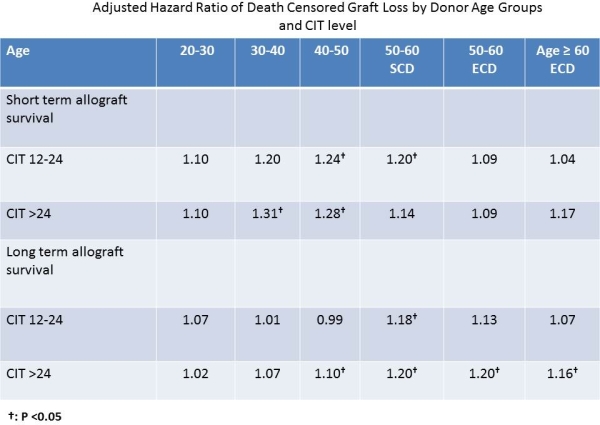The Long and Short of Old and Cold on Renal Allograft Outcomes.
1University of Michigan, Ann Arbor
2Saint Louis University, St. Louis.
Meeting: 2016 American Transplant Congress
Abstract number: C181
Keywords: Age factors, Cadaveric organs, Kidney transplantation
Session Information
Session Name: Poster Session C: Kidney Transplantation: AKI/Preservation/DCD
Session Type: Poster Session
Date: Monday, June 13, 2016
Session Time: 6:00pm-7:00pm
 Presentation Time: 6:00pm-7:00pm
Presentation Time: 6:00pm-7:00pm
Location: Halls C&D
Introduction: Donor age and cold ischemia times (CIT) have been shown to have independent and varying degrees of impact on short and long term risk of allograft failure. While aged and suboptimal kidneys are more likely to be susceptible to ischemic injury, the data to support such a hypothesis is limited. A prior paired analysis of Expanded Criteria Donor (ECD) kidneys showed no impact of increasing CIT on allograft outcomes (Kayler, AJT, 2011). We hypothesized that increasing CIT is an effect modifier of the impact of donor age on short and long term allograft survival.
Methods: Primary deceased donor kidney only transplant recipients from April 1,1994 through June 30, 2013 with follow up through June 30, 2014 were included. Outcome of interest was short (1 yr) and long-term (>1 yr) death censored allograft survival. Donor age was divided into 10-year increments from age 20 to 60 and all others > 60 in one group. CIT was divided into 0-12 hr (reference for each age group), 12-24 hr and > 24 hours. We performed a Cox proportional hazards regression for individual donor age groups by CIT adjusted for various donor, recipient and transplantation factors.

Results: Increasing CIT increases the risk of short and long term allograft loss and this effect increases with donor age among SCD transplants (Table). While any level of CIT does not appear to worsen short-term allograft survival among ECD transplants, long CIT (>24 hours) predicts increased risk of long term ECD graft loss .
Conclusion: Increasing CIT has a significant impact on short and long term outcomes as donor age increases. This effect is more pronounced in SCD compared to ECD transplants. The apparent resilience of ECD allograft to detrimental impacts of CIT is likely due to the presence of other competing disease processes or excessive right-censoring due to death.
CITATION INFORMATION: Naik A, Luan D, Lentine K, Rao P, Sakhuja A, Huang Y, Samaniego M, Norman S, Ojo A, Cibrik D. The Long and Short of Old and Cold on Renal Allograft Outcomes. Am J Transplant. 2016;16 (suppl 3).
To cite this abstract in AMA style:
Naik A, Luan D, Lentine K, Rao P, Sakhuja A, Huang Y, Samaniego M, Norman S, Ojo A, Cibrik D. The Long and Short of Old and Cold on Renal Allograft Outcomes. [abstract]. Am J Transplant. 2016; 16 (suppl 3). https://atcmeetingabstracts.com/abstract/the-long-and-short-of-old-and-cold-on-renal-allograft-outcomes/. Accessed December 26, 2025.« Back to 2016 American Transplant Congress
